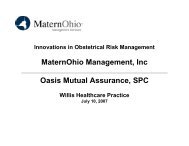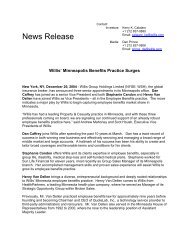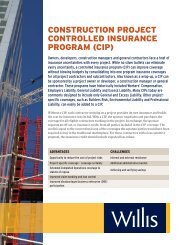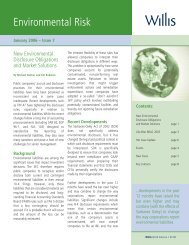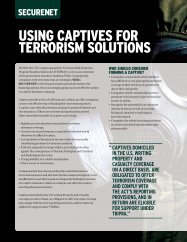CONTROLLING THE INCREASED FIRE RISKS OF IBCs - Willis
CONTROLLING THE INCREASED FIRE RISKS OF IBCs - Willis
CONTROLLING THE INCREASED FIRE RISKS OF IBCs - Willis
Create successful ePaper yourself
Turn your PDF publications into a flip-book with our unique Google optimized e-Paper software.
If the storage of nonmetallic or composite <strong>IBCs</strong> is necessary,<br />
they should be stored off-site or in detached, contained storage<br />
areas away from the plant or in commercially available<br />
flammable or combustible liquids storage structures designed<br />
for handling <strong>IBCs</strong>.<br />
If the only option is storage of nonmetallic or composite <strong>IBCs</strong> in<br />
the plant, consider minimizing the storage within the key areas<br />
of the plant to one IBC tote in widely separated dispensing or<br />
end use areas. Provide adequately sized containment areas or<br />
high-sided steel containment designed to prevent the sudden<br />
release of liquid. IBC totes should be provided with a double<br />
block to provide spill protection from potential damage to the<br />
dispensing valve.<br />
Isolate the storage of nonmetallic or composite <strong>IBCs</strong> from steel<br />
drums containing other combustible or flammable liquids.<br />
If necessary, the interior storage of <strong>IBCs</strong> should be limited to<br />
rooms with minimum two-hour fire resistance-rated<br />
construction and equipped as flammable or combustible liquids<br />
rooms as outlined in NFPA 30 and FM Data Sheet 7-29. Such<br />
rooms typically include adequate spill containment and/or<br />
drainage, automatic sprinkler protection and perhaps the use of<br />
AFFF foam protection.<br />
ADDITIONAL INFORMATION<br />
For additional information on the storage and handling of flammable<br />
and combustible liquids please refer to the following:<br />
National Fire Protection Association (NFPA) Flammable and<br />
Combustible Liquids Code (NFPA 30)<br />
Factory Mutual Loss Prevention Data Sheet 7-29 (Flammable<br />
Liquid Storage in Portable Containers)<br />
4<br />
COST VS. SAFETY<br />
As previously noted, the handling of liquids in<br />
<strong>IBCs</strong> can yield significant cost savings and<br />
operating efficiency; however, the fire hazard<br />
posed by such large volumes of flammable<br />
and combustible liquids has been determined<br />
by fire tests to be more severe than the hazard<br />
posed by the storage and handling of<br />
traditional 55-gallon drum and/or smaller<br />
capacity containers. We recommend that you<br />
discuss any proposed plans or existing<br />
storage situations for flammable and<br />
combustible liquids with a Property Risk<br />
Control consultant before reaching a final<br />
decision.<br />
CONTACTS<br />
If you would like additional information on<br />
this or other risk control topics, contact your<br />
local <strong>Willis</strong> Property Risk Control<br />
representative or:<br />
Alan Dopart, PE, CSP<br />
Senior Property Risk Control Consultant<br />
<strong>Willis</strong> Strategic Outcomes Practice<br />
973 829 2916<br />
alan.dopart@willis.com<br />
Joe Stavish, PE<br />
National Technical Director<br />
Property Risk Control<br />
<strong>Willis</strong> Strategic Outcomes Practice<br />
973 829 2955<br />
joe.stavish@willis.com<br />
The objective of our publication is to provide a<br />
general overview and discussion of issues relevant<br />
to loss control. The comments and suggestions<br />
presented should not be taken as a substitute for<br />
advice about any specific situation.<br />
<strong>Willis</strong> North America • 01/10



